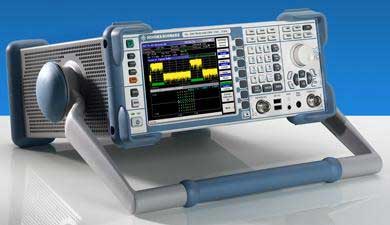A spectrum analyzer or spectral analyzer is a device used to examine the spectral composition of some electrical, acoustic, or optical waveform. It may also measure the power spectrum. Types There are analog and digital spectrum analyzers: * An analog spectrum analyzer uses either a variable band-pass filter whose mid-frequency is automatically tuned (shifted, swept) through the range of frequencies of which the spectrum is to be measured or a superheterodyne receiver where the local oscillator is swept through a range of frequencies. Some spectrum analyzers (such as "real-time spectrum analyzers") use a hybrid technique where the incoming signal is first down-converted to a lower frequency using superheterodyne techniques and then analyzed using fast fourier transformation (FFT) techniques.
Spectrum analyzer from Rohde & Schwarz (*) Typical functionality Frequency Allows one to fix the window of frequencies to visualize .... Marker/peak search Controls the position and function of markers and indicates the value of power. Bandwidth/average Is a filter of resolution. The spectrum analyzer captures the measure on having displaced a filter of small bandwidth along the window of frequencies. Amplitude The maximum value of a signal at a point is called amplitude. A spectrum analyzer that implements amplitude analysis is called a Pulse height analyzer. View/trace Manages parameters of measurement. It stores the maximum values in each frequency and a solved measurement to compare it. Operation Usually, a spectrum analyzer displays a power spectrum over a given frequency range, changing the display as the properties of the signal change. There is a trade-off between how quickly the display can be updated and the frequency resolution, which is for example relevant for distinguishing frequency components that are close together. With a digital spectrum analyzer, the frequency resolution is Δν = 1 / T, the inverse of the time T over which the waveform is measured and Fourier transformed (according to Uncertainty principle). With an analog spectrum analyzer, it is dependent on the bandwidth setting of the bandpass filter. However, an analog spectrum analyzer will not produce meaningful results if the filter bandwidth (in Hz) is smaller than the square root of the sweep speed (in Hz/s)[citation needed], which means that an analog spectrum analyzer can never beat a digital one in terms of frequency resolution for a given acquisition time. Choosing a wider bandpass filter will improve the signal-to-noise ratio at the expense of a decreased frequency resolution. With Fourier transform analysis in a digital spectrum analyzer, it is necessary to sample the input signal with a sampling frequency νs that is at least twice the highest frequency that is present in the signal, due to the Nyquist limit. A Fourier transform will then produce a spectrum containing all frequencies from zero to νs / 2. This can place considerable demands on the required analog-to-digital converter and processing power for the Fourier transform. Often, one is only interested in a narrow frequency range, for example between 88 and 108 MHz, which would require at least a sampling frequency of 216 MHz, not counting the low-pass anti-aliasing filter. In such cases, it can be more economic to first use a superheterodyne receiver to transform the signal to a lower range, such as 8 to 28 MHz, and then sample the signal at 56 MHz. This is how an analog-digital-hybrid spectrum analyzer works. For use with very weak signals, a pre-amplifier can be used, although harmonic and intermodulation distortion may lead to the creation of new frequency components that were not present in the original signal. A new method, without using a high local oscillator (LO) (that usually produces a high-frequency signal close to the signal) is used on the latest analyzer generation like Aaronia´s Spectran series. The advantage of this new method is a very low noise floor near the physical thermal noise limit of -174 dBm/Hz. RF uses Spectrum analyzers are widely used to measure the frequency response, noise and distortion characteristics of all kinds of RF circuitry, by comparing the input and output spectra. In telecommunications, spectrum analyzers are used to determine occupied bandwidth and track interference sources. Cellplanners use this equipment to determine interference sources in the GSM/TETRA and UMTS technology. In EMC testing, spectrum analyzers may be used to characterise test signals and to measure the response of the equipment under test. See also * Electrical measurements
External links
Retrieved from "http://en.wikipedia.org/" |
|


